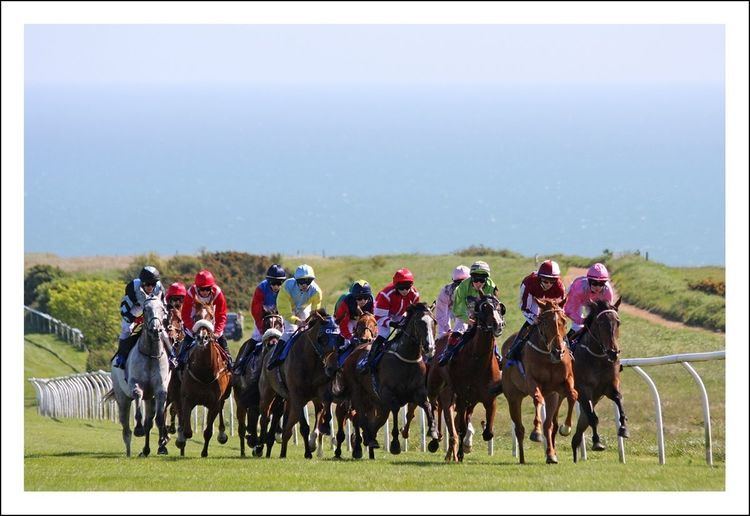Phone +44 1273 603580 Course type Flat racing | Screened on At the Races | |
 | ||
Similar Fontwell Park Racecourse, Bath Racecourse, Stanmer Park, The Lanes, Brighton Marina Profiles | ||
Brighton racecourse flyover
Brighton Racecourse is an English horse racing venue located a mile to the northeast of the centre of Brighton, Sussex owned by the Arena Racing Company.
Contents
- Brighton racecourse flyover
- Bheleyf wins at brighton racecourse
- Location and layout
- History
- Major races
- Memorable events
- Other events
- References
Bheleyf wins at brighton racecourse
Location and layout
It is situated on Whitehawk Hill, on the edge of the South Downs about four hundred feet above sea level and a mile from the coast. The track takes the form of a horseshoe one and a half miles in length. This makes it one of the few British courses not to form a complete circuit, like Epsom with which Brighton is sometimes compared. The finishing straight is about four furlongs in length, with a steep descent followed by a slightly less steep climb to the winning post. It is a left-handed course, used for flat racing only. The longest race run today is 1 1/2 miles. However, the course used to extend a further half mile across the golf course towards Roedean. This made four mile races possible, starting at the winning post and going the reverse way round the track, then looping at the two mile start and returning the conventional way. Hurdle races were also formerly held at Brighton, with one being situated on the steep downhill.
History
The Duke of Cumberland organised the first public racing at the current site in 1783 although racing had been taking place in Brighton from before 1713. Early races were contested by members of the armed forces who were garrisoned in the town. The principle meeting took place in July or August and was timed to fit with the local Whitehawk Fair, which was discontinued by the 1820s. According to legend, George IV, when still Prince of Wales, invented hurdle racing at Brighton while out riding with aristocratic friends. They found some sheep pens which they proceeded to jump. A grandstand was erected in 1788, but burnt down on 23 August 1796, a fire blamed on a family of paupers who had been allowed to live in it.
In 1805, the races were faced with severe disruption when the farmer who leased the racecourse threatened to plough it up unless he received the complimentary gift of wine he usually got each season. He was in the process of beginning to plough when he was chased off by a press gang and the races allowed to continue.
The course was home for a while to top class racing, and was attended by fashionable society, but it drifted out of fashion when the Prince and his friends ceased to attend. By 1850 the railway had arrived in Brighton, allowing greater access for Londoners, and the course began to thrive again. A new stand was built and the Brighton Cup inaugurated. Brighton's main meeting formed part of the "Sussex Fortnight" in summer - where the Glorious Goodwood festival was followed up by big meetings at Brighton and Lewes.
Crowds rose to over 20,000 in the period following World War II. At the time, grandstands existed on both sides of the home straight. In the 1960s, the course held a Derby Trial. No runners went on to win the Derby, but two won the St. Leger. A new stand was built for £400,000 in 1965. Attendance declined as Brighton's tourist industry did, and the facility became run down. Racecourse owning group Northern Racing took a majority stake in 1998 and spent £4m refurbishing the course. As of 1999, Northern owned 81% of the course with Brighton & Hove City Council retaining a 19% interest. Northern Racing merged with Arena Racing in 2012 to become the Arena Racing Company.
Major races
Today, Brighton is one of the smaller racecourses in Britain in terms of the quality of racing and prize money offered. In 2012/13, its average prize money per meeting was £26,349. Only Southwell, Chepstow and Folkestone (now closed) offered less.
The season’s highlight is the three-day Brighton Festival in early August, which has always been the time of its main meeting. The main event is the Brighton Mile Challenge Trophy Handicap, sponsored by John Smith’s since 2003. In 2012, Brighton hosted meetings on 18 days.
Memorable events
Prominent racehorse owner, Sheikh Mohammed, had his first winner at Brighton racecourse on 20 June 1977 when his filly Hatta, trained by John Dunlop, won the £968 Bevendene Maiden Stakes. Top American jockey, Steve Cauthen also reached a milestone at the course - winning his 1000th British race on odds on favourite Picnicing on 5 August 1987.
Cricketer Ted Dexter used to frequent Brighton races and is said to have once declared an innings for Sussex from the course.
Other events
The course is also available as a venue for exhibitions, conferences, car rallies, circuses, antique fairs, business promotions and product launches, wedding receptions and other private parties.
